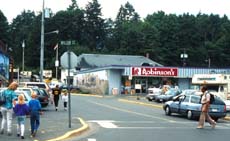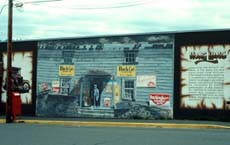Logging the Past

Mural in Chemainus, British Columbia

Street scene in Chemainus, British Columbia

Mural in Chemainus, British Columbia
In Chemainus, on Vancouver Island in British Columbia, the sawmill that supported the town's economy went out of business. Seeking economic survival, the citizens decided to memorialize their past as a lumbering town. They painted on the sides of their buildings large murals of log drives, timber work, loggers -- their history. Many of the buildings now present painted images of their own earlier conditions and use. The ploy worked; tourists came; the town prospered so much that when the sawmill eventually reopened it was no longer so central to the town's economy.
We should resist a simplistic interpretation of these events as the Baudrillardian simulacrum in action. The town did turn itself into an image of itself at the very time when the conditions that would support that older self disappear. The town then sells that image in the tourist economy of exchange, visibility, and quick interaction. The tourists buy a conveniently wrapped experience of a way of life no longer in the town, and a past that no longer exists.
The town turned itself into an image in order to survive on the rough seas of international business. This is not Disneyland floating on oceans of capital. When I talked to people who lived nearby, they were proud of the way Chemainus had saved itself by inventing a business. Once the sawmill reopens, that business is . . . a business. Vancouver Island's economy seems to be forest products and tourism, and the town had managed to move from one category to the other. No big deal, the neighbors thought. Nothing postmodern.